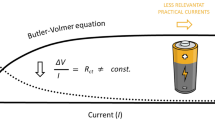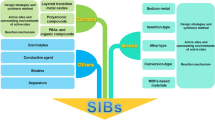Abstract
The results of digital simulation of the lithium peroxide formation during the lithium–oxygen battery discharge are presented. The active layer of the positive electrode is described by the simplest monoporous model of a porous medium (a set of sinuous homogeneous non-intersecting pores of constant radius). The influence of the active layer thickness on the positive electrode dimensional characteristics during the galvanostatic discharge of the lithium–oxygen battery is investigated. The dependence of the discharge capacity on the positive electrode active layer thickness was shown to have an extreme character. With increase in the positive electrode active layer thickness the initial section of the increase in the calculated capacity is replaced by a section of a decrease in the capacity. It was found that the process of lithium peroxide molecules’ generation mainly occurs within a narrow region where the pore mouths are in contact with the gas phase. The calculations show that the optimal thickness of the positive electrode active layer is very small (of the order of tens of microns).






Similar content being viewed by others
Notes
Here and below, the term “the specific capacity” means the capacity per the positive electrode geometrical surface area (mA h/cm2).
REFERENCES
Zhang, X.-Q., Zhao, C.-Z., Huang, J.-Q., and Zhang, Q., Recent Advances in Energy Chemical Engineering of Next-Generation Lithium Batteries, Engineering, 2018, vol. 4, p. 831.
Shu, C., Wang, J., Long, J., Liu, H.-K., and Dou, S.-X., Understanding the Reaction Chemistry during Charging in Aprotic Lithium–Oxygen Batteries: Existing Problems and Solutions, Adv. Mater., 2019, vol. 31, p. 1804587.
Tarasevich, M.R., Andreev, V.N., Korchagin, O.V., and Tripachev, O.V., Lithium–oxygen (air) batteries (state-of-the-art and perspectives), Prot. Met. Phys. Chem. Surf., 2017, vol. 53, p. 1.
Laoire, C.O., Mukerjee, S., Abraham, K.M., Plichta, E.J., and Hendrickson, M.A., Elucidating the mechanism of oxygen reduction for lithium-air battery applications, J. Phys. Chem. C, 2009, vol. 113, p. 20127.
Liu, C., Sato, K., Han, X.-B., and Ye, S., Reaction mechanisms of the oxygen reduction and evolution reactions in aprotic solvents for Li–O2 batteries, Curr. Opin. Electrochem., 2019, vol. 14, p. 151.
Ottakam Thotiyl, M.M., Freunberger, S.A., Peng, Z., and Bruce, P.G., The Carbon Electrode in Nonaqueous Li–O2 Cells, J. Am. Chem. Soc., 2013, vol. 135, p. 494.
Tarasevich, M.R., Korchagin, O.V., and Tripachev, O.V., Comparative Study of Special Features of the Oxygen Reaction (Molecular Oxygen Ionization and Evolution) in Aqueous and Nonaqueous Electrolyte Solutions (a Review), Russ. J. Electrochem., 2018, vol. 54, p. 1.
Liu, T., Leskes, M., Yu, W., Moore, A.J., Zhou, L., Bayley, P.M., Kim, G., and Grey, C.P., Cycling Li–O2 batteries via LiOH formation and decomposition, Science, 2015, vol. 350, p. 530.
Gao, J., Cai, X., Wang, J., Hou, M., Lai, L., and Zhang, L., Recent progress in hierarchically structured O2-cathodes for Li–O2 batteries, Chem. Eng. J., 2018, vol. 352, p. 972.
Wang, H., Wang, H., Huang, J., Zhou, X., Wu, Q., Luo, Z., and Wang, F., Hierarchical Mesoporous/Macroporous Co-doped NiO Nanosheet Arrays as Free-standing Electrode Materials for Rechargeable Li–O2 Batteries, ACS Appl. Mater. Interfaces, 2019, vol. 11, p. 44556.
Bogdanovskaya, V.A., Chirkov, Y.G., Rostokin, V.I., Yemetz, V.V., Korchagin, O.V., Andreev, V.N., and Tripachev, O.V., The Effect of the Structure of a Positive Electrode on the Process of Discharge of a Lithium–Oxygen Power Source. The Monoporous Cathode Theory, Prot. Met. Phys. Chem. Surf., 2018, vol. 54, p. 1015.
Chen, W., Yin, W., Shen, Y., Huang, Z., Li, X., Wang, F., Zhang, W., Deng, Z., Zhang, Z., and Huang, Y., High areal capacity, long cycle life Li–O2 cathode based on highly elastic gel granules, Nano Energy, 2018, vol. 47, p. 353.
Jiang, J., Deng, H., Li, X., Tong, S., He, P., and Zhou, H., Research on Effective Oxygen Window Influencing the Capacity of Li–O2 Batteries, ACS Appl. Mater. Interfaces, 2016, vol. 8, p. 10375.
Spencer, M.A. and Augustyn, V., Free-standing transition metal oxide electrode architectures for electrochemical energy storage, J. Mater. Sci., 2019, vol. 54, p. 13045.
Nomura, A., Ito, K., and Kubo, Y., CNT Sheet Air Electrode for the Development of Ultra-High Cell Capacity in Lithium–Air Batteries, Sci. Rep., 2017, vol. 7, p. 45596.
Xiao, J., Wang, D., Xu, W., Wang, D., Williford, R.E., Liu, J., and Zhang, J.-G., Optimization of Air Electrode for Li/Air Batteries, J. Electrochem. Soc., 2010, vol. 157, p. A487.
Landa-Medrano, I., Pinedo, R., Ruiz de Larramendi, I., Ortiz-Vitoriano, N., and Rojo, T., Monitoring the Location of Cathode-Reactions in Li–O2 Batteries, J. Electrochem. Soc., 2015, vol. 162, p. A3126.
Lin, Y., Moitoso, B., Martinez-Martinez, C., Walsh, E.D., Lacey, S.D., Kim, J.-W., Dai, L., Hu, L., and Connell, J.W., Ultrahigh-Capacity Lithium–Oxygen Batteries Enabled by Dry-Pressed Holey Graphene Air Cathodes, Nano Lett., 2017, vol. 17, p. 3252.
Li, J., Su, Z., Zhang, T., Li, Q., Yu, M., Zhang, X., and Sun, H., Highly Efficient Li–Air Battery Using Ultra-Thin Air Electrode, J. Electrochem. Soc., 2019, vol. 166, p. A3606.
Bao, J., Hu, W., Bhattacharya, P., Stewart, M., Zhang, J.-G., and Pan, W., Discharge performance of Li–O2 batteries using a multiscale modeling approach, J. Phys. Chem. C., 2015, vol. 119, p. 14851.
Chirkov, Y.G., Korchagin, O.V., Andreev, V.N., Bogdanovskaya, V.A., and Rostokin, V.I., Dischage of Lithium–Oxygen Power Source: Effect of Active Layer Thickness and Current Density on Overall Characteristics of Positive Electrode, in: Advances in Intelligent Systems and Computing, Silhavy, R., Silhavy, P., and Prokopova, Z., Eds., Springer, 2019, vol. 1047, p. 52.
Chirkov, Y.G., Rostokin, V.I., Andreev, V.N., and Bogdanovskaya, V.A., Digital Simulation of the Structure and Operation Mechanisms for the Active layer of Lithium–Oxygen Battery Cathode, Russ. J. Electrochem., 2020, vol. 56, p. 230.
Chirkov, Yu.G., Rostokin, V.I., Andreev, V.N., Bogdanovskaya, V.A., and Korchagin, O.V., Lithium–Oxygen Power Source: The Influence of Positive Electrode Thickness on the Overall Discharge Characteristics, Russ. J. Electrochem., 2020, vol. 56, p. 596.
Sandhu, S., Fellner, J., and Brutchen, G., Diffusion-limited model for a lithium/air battery with an organic electrolyte, J. Power Sources, 2007, vol. 164, p. 365.
Dabrowski, T., Struck, A., Fenske, D., Maaß, P., and Colombi, L.C., Optimization of Catalytically Active Sites Positioning in Porous Cathodes of Lithium/Air Batteries Filled with Different Electrolytes, J. Electrochem. Soc., 2015, vol. 162, p. A2796.
Read, J., Mutolo, K., Ervin, M., Behl, W., Wolfenstine, J., Driedger, A., and Foster, D., Oxygen Transport Properties of Organic Electrolytes and Performance of Lithium/Oxygen Battery, J. Electrochem. Soc., 2003, vol. 150, p. A1351.
Chirkov, Y.G., Andreev, V.N., Rostokin, V.I., and Bogdanovskaya, V.A., Discharge of Lihium–Oxygen Power Source: The Monoporous Cathode Theory and Role of Constant of Oxygen Consumption Process, Al’ternativnaya Energetika Ekologiya (in Russian), 2018, nos. 4–6, p. 95.
Pan, W., Yang, X., Bao, J., and Wang, M., Optimizing discharge capacity of Li–O2 Batteries dy design of air-electrode porous structure: Multifidelity modeling and optimization, J. Electrochem. Soc., 2017, vol. 164, p. E3499.
Louis, C. and Benoit, R.L., The electrochemical reduction of oxygen in sulpholane, Electrochim. Acta, 1973, vol. 18, p. 7.
Funding
This work was supported by the Ministry of science and higher education of RF.
Author information
Authors and Affiliations
Corresponding authors
Ethics declarations
The authors declare that they have no conflict of interest.
Additional information
Translated by Yu. Pleskov
Rights and permissions
About this article
Cite this article
Chirkov, Y.G., Rostokin, V.I., Korchagin, O.V. et al. Galvanostatic Discharge of Lithium–Oxygen Battery: The Influence of the Active Layer Thickness on the Positive Electrode Characteristics. Russ J Electrochem 58, 50–59 (2022). https://doi.org/10.1134/S1023193522010049
Received:
Revised:
Accepted:
Published:
Issue Date:
DOI: https://doi.org/10.1134/S1023193522010049




